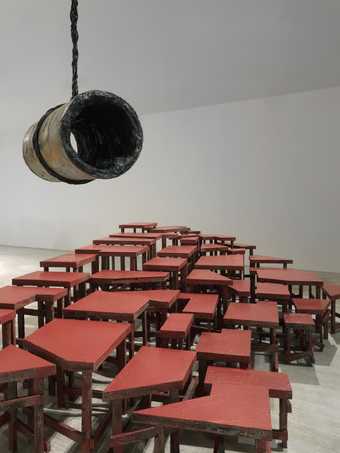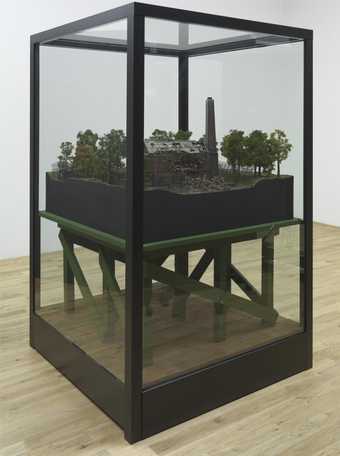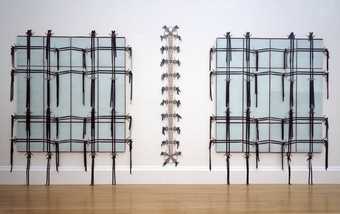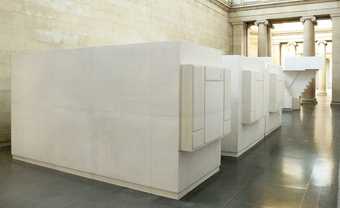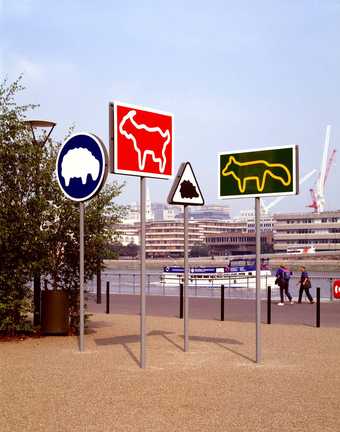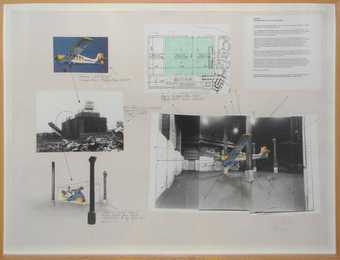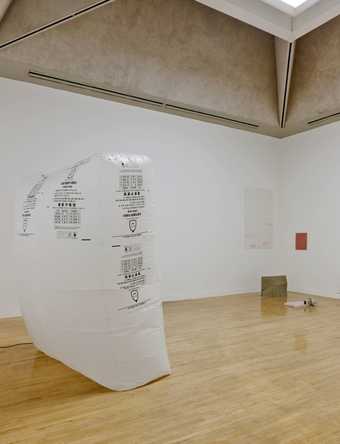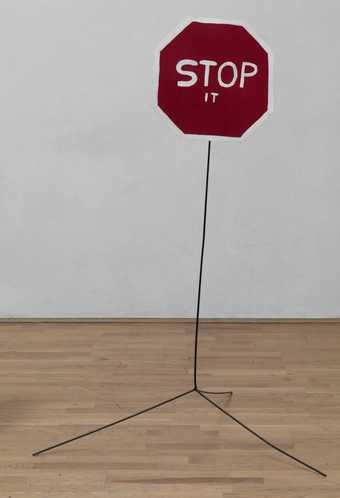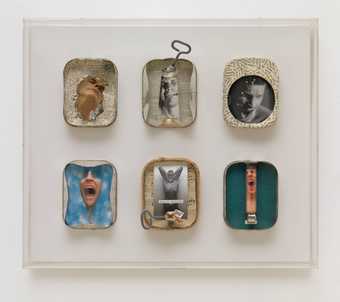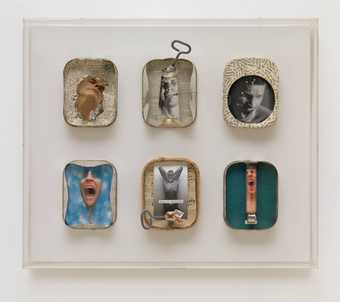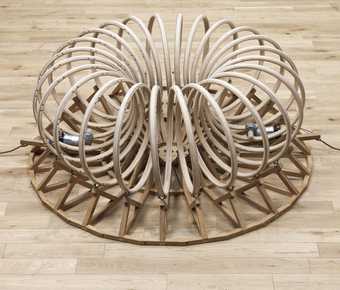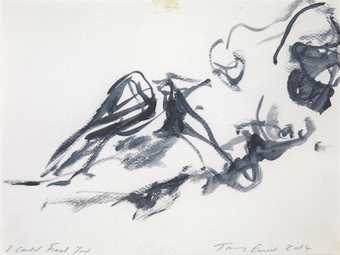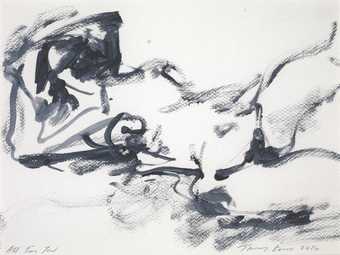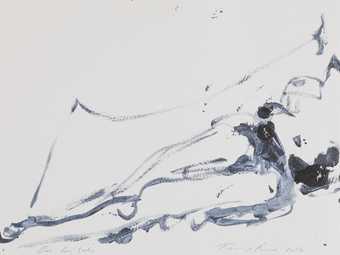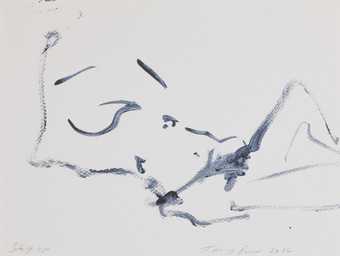
In Tate Modern
Exhibition
A World in Common: Contemporary African Photography
A celebration of the varied landscape of contemporary African photography today
- Artist
- Khadija Saye 1992–2017
- Medium
- Tintype on metal
- Dimensions
- Frame: 418 × 370 × 37 mm
image: 243 × 194 mm - Collection
- Tate
- Acquisition
- Presented by Tate Patrons 2019
- Reference
- T15140
Summary
Nak Bejjen is a photograph from Khadija Saye’s series Dwelling: in this space we breathe 2017. Originally numbering somewhere between twenty and thirty wet plate collodion tintype photographs, only six works from the series remain, the large part having been destroyed in a fire in which the artist also lost her life. The works were executed with the assistance of artist Almudena Romero and depict Saye as the subject of a series of portraits in which she enacts invented rituals using sacred objects from her parents’ country of origin, Gambia.
In this particular tintype, Saye is shown in black and white, as is typical of the wet collodion process. She is seated, side on to the viewer, wearing an outfit made from a dark fabric with a head covering in a slightly lighter fabric bound around her head. Her head is bowed, as if in prayer and someone stands behind her, mostly outside the frame. This person’s outstretched arm, covered in a white knitted sleeve, reaches into the frame, holding a horn-like object to the nape of Saye’s neck. The title, Nak Bejjen, means cow horn. Plumes of what look like smoke appear to be coming from the top of this horn-like object, but the exact nature of this invented ritual remains ambiguous. Considering the volatility of the wet plate collodion tintype medium, which is easily affected by elements outside the artist’s control, these forms may be an unplanned result of the printing process to which Saye surrendered, as if to a higher power.
Having been brought up in a dual faith household with a Muslim father and Christian mother, Saye was well attuned to questions of identity and, particularly, to the role which faith plays in determining that identity. At sixteen she was awarded a full scholarship to study at the prestigious Rugby School in Warwickshire, the new world of privilege into which she was thrust providing a stark contrast to the area of Ladbroke Grove in west London where she was raised. In a BBC documentary in 2017, Saye discussed the fact that during her time at Rugby her sense of ‘otherness’ heightened and described the feeling of being an outsider looking in on a world of opulence and opportunity.
After graduating from her degree, her work revolved around portraiture and the interrogation of identity. In 2016 she visited Gambia and photographed family members and friends for a series entitled Home. Coming. This interest in Gambian culture and ritual fed into the series of work that would become Dwelling: in this space we breathe. The series was shown in the Diaspora Pavilion at the Venice Biennale in 2017 and explores what the catalogue for that exhibition describes as ‘the migration of traditional Gambian spiritual practices and the deep rooted urge to find solace within a higher power’ (Venice Biennale 2017, p.42, online at https://abe6925c50.site.internapcdn.net/wp-content/uploads/2017/05/DP_A5_EXHIBITION_BOOK_FINAL_Web.pdf, accessed 16 November 2017). In an Instagram takeover which she undertook for the Metro Imaging account in 2017, Saye discussed how integral faith and religion are to members of the diaspora attempting to establish and maintain connections to the homes which have been left behind.
Immediately preceding the series, Saye was involved in a personally traumatic episode and the photographs have a suggestion of self-healing; the series depicts imagined rituals but came about through a need for spiritual grounding which Saye was working through. Using herself as the subject enabled Saye to engage deeply and instinctively with the way in which trauma is embodied in the black experience. The work calls into question the processes or objects that we turn to for succour in life’s most challenging moments. The element of healing in these works is present not only in the subject matter, but also in the physical process of image-making, through Saye’s decision to use a nineteenth-century photographic technique, as detailed in the catalogue for the Diaspora Pavilion:
The journey of making wet plate collodion tintypes is unique; no image can be replicated and the final outcome is beyond the creator’s control. Within this process, you surrender yourself to the unknown, similar to what is required by all spiritual higher powers: surrendering and sacrifice. Each tintype has its own unique story to tell, a metaphor for our individual human spiritual journey. The process of submerging the collodion covered plate into a tank of silver nitrate ignites memories of baptisms, the idea of purity and how we cleanse in order to be spiritually sound. The application of the collodion transcends the photographic process; it is a reflection, a physical manifestation of the artist’s subconscious relationship to traditional African spirituality. The process involved with tintypes addresses the current disposable era where materials are rapidly produced and short lived. We forget to live through the moment, remaining in the silence, and working on our internal connections.
(Venice Biennale 2017, p.42, accessed 16 November 2017.)
Further reading
David A. Bailey, Jessica Taylor, Diaspora Pavilion, exhibition catalogue, 57th Venice Biennale 2017.
Aïcha Mehrez
November 2017, revised October 2018
Does this text contain inaccurate information or language that you feel we should improve or change? We would like to hear from you.
Display caption
These self-portraits explore traditional spiritual practices as a way of connecting to ancestral homelands. Saye performs a series of rituals using sacred objects that combine her African, Christian and Islamic heritage. In Nak Bejjen, Wolof for cow horn, Saye’s head is bowed in prayer while a figure outside the frame holds a horn-like object to the back of her neck. The image evokes a technique used by Gambian healers to draw impurities from a person’s body. Saye commented that ‘whilst exploring the notions of spirituality and rituals, the process of image making became a ritual in itself’. She used a labour-intensive wet collodion process, which is easily affected by elements outside the artist’s control. Saye explained, ‘within this process, you surrender yourself to the unknown, similar to what is required by all spiritual higher powers: surrendering and sacrifice.’
Gallery label, June 2023
Does this text contain inaccurate information or language that you feel we should improve or change? We would like to hear from you.
You might like
-
Dame Phyllida Barlow DBE RA untitled: brokenstage/hangingcontainer, 2012/2013
2012–3 -
Dinos Chapman, Jake Chapman Arbeit McFries
2001 -
Cathy De Monchaux Wandering about in the future, looking forward to the past
1994 -
Rachel Whiteread Untitled (Rooms)
2001 -
Julian Opie Escaped Animals
2002 -
Richard Wilson Butterfly
2003 -
Ian Kiaer Ulchiro Project
2007 -
David Shrigley OBE Stop It
2007 -
Martin Cullen Concentration
c.1992 -
Martin Cullen In the Grip II
c.1992 -
Conrad Shawcross Maquette for Continuum
2004 -
Tracey Emin I Could Feel You
2014 -
Tracey Emin All for You
2014 -
Tracey Emin On her Side
2014 -
Tracey Emin Stay Up
2014

